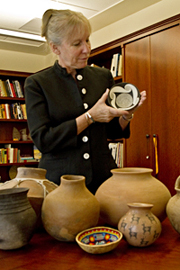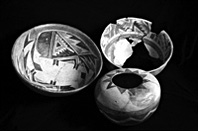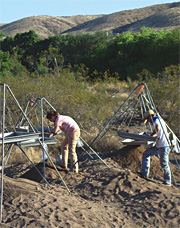August 30, 2010
Q&A with Margaret Nelson

Dr. Nelson admires a classic Mimbres black-on-white pot of the 11th century style.

Three pottery vessels from the 12th century combine old and emerging styles.

Soil from a 12th century pueblo in southwest New Mexico is carefully sifted to recover artifacts.
Dr. Nelson is a professor in the School of Sustainability and the School of Human Evolution and Social Change and is Vice Dean of Barrett, the Honors College. Her research involves collaborative fieldwork to understand sustainability issues for prehistoric inhabitants of the U.S. Southwest and the lessons that can be learned for contemporary society. Her innovations in teaching have earned her the ASU President’s Professor Award, Professor of the Year honors from the ASU Parents Association, and the Centennial Professor designation by the Associated Students of ASU. Nelson teaches graduate and undergraduate seminars in interdisciplinary research for the School of Sustainability.
Dr. Nelson is a professor in the School of Sustainability and the School of Human Evolution and Social Change and is Vice Dean of Barrett, the Honors College. Her research involves collaborative fieldwork to understand sustainability issues for prehistoric inhabitants of the U.S. Southwest and the lessons that can be learned for contemporary society. Her innovations in teaching have earned her the ASU President’s Professor Award, Professor of the Year honors from the ASU Parents Association, and the Centennial Professor designation by the Associated Students of ASU. Nelson teaches graduate and undergraduate seminars in interdisciplinary research for the School of Sustainability.
How did “sustainability” become part of your research focus?
In 1999 the Turner Foundation awarded my research partner and me a three-year grant to study how the Mimbres culture in southwestern New Mexico practiced sustainable land use. With the help of further grants by the Turner Foundation, National Geographic, and the National Science Foundation, we began collaborating with a group of archaeologists and ecologists working in the U.S. Southwest and northern Mexico to understand issues of sustainability and resilience over long time spans.
What is your most important sustainability-related research project?
I lead an interdisciplinary research group from the fields of ecology and anthropology who are conducting integrated projects that examine cycles of stability and transformation during the last 1,000 years in the U.S. Southwest and northern Mexico. The projects focus on a number of key assumptions about resilience and sustainability that have never before been studied across such long periods. Our work involves building an extended record of evidence that explains how issues such as diversity, robustness, vulnerability, and social rigidity can contribute to a society’s stability or collapse.
How do you think your sustainability-related research can affect decisions in the “real world”?
Policymakers and managers currently make decisions based on recent evidence and short-term consequences. Our work provides a considerably longer record of evidence about the processes that either contribute to or interfere with resilience and sustainability. With this much broader understanding, decision-makers have the tools to make better choices for a sustainable future that is lasting.
What is the world sustainability challenge that concerns you the most?
I cannot pick only one. Among the concerns on my list are social isolation policies, high population, abysmal quality of life for many, inattention to future consequences, and lack of education.
August 30, 2010

